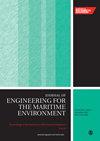使用耦合计算流体动力学和机器学习方法建模和评估意外海底气体泄漏
IF 1.5
4区 工程技术
Q3 ENGINEERING, MARINE
Proceedings of the Institution of Mechanical Engineers, Part M: Journal of Engineering for the Maritime Environment
Pub Date : 2022-11-05
DOI:10.1177/14750902221127755
引用次数: 0
摘要
在世界各地,石油和天然气工业是最重要的能源来源。海底油气泄漏的可能性正在增加,这可能对海洋环境造成威胁和有害影响,并可能发生火灾、爆炸和海底基础设施结构完整性丧失等灾难性事件。此外,物理模型通常用于预测海流,但它们对干扰不稳定,因此在很长一段时间内是不正确的。机器学习方法比通常用于预测海流的物理模型更具抵抗力。此外,物理模型通常用于预测海流。但是,它们对干扰是不稳定的,因而在长期内是不正确的。机器学习方法比通常用于预测海流的物理模型更具抵抗力。机器学习方法更能抵抗变化和扰动。因此,本研究的目的是通过改变对气体羽流的影响参数来评估海底管道破裂至到达海面的气体羽流的潜在危害,通过开发耦合模型来评估和模拟海底气体释放,以帮助石油公司制定风险评估策略,从而控制泄漏,其中一个模型用于机器学习代码,该模型可以使用多元线性回归算法预测即将到来的水流速度通过UDF将其连接到第二个模型,该模型实现了计算流体动力学(CFD)模型,以研究电流效应下的海底气体释放。Engebretsen的Rotvoll实验数据被用来验证数值计算流体动力学模型。在水流存在的情况下,通过改变泄漏孔大小、水流速度、气速、水深等影响参数来评价瓦斯分散,瓦斯释放的上升时间、喷泉高度和水平迁移是评价瓦斯分散时必须考虑的因素。此外,将我们的模拟应用于埃及一家石油公司的实际情况参数。这些发现可能有助于评估海底天然气泄漏事件的危害和响应计划。本文章由计算机程序翻译,如有差异,请以英文原文为准。
Modeling and assessment of accidental subsea gas leakage using a coupled computational fluid dynamics and machine learning approaches
All over the world, the oil and gas industries are the most important source of energy. The likelihood of subsea gas and oil leakage is increasing, which can cause threats and harmful impacts on the marine environment and potentially catastrophic events such as fires, explosives, and the loss of structural integrity of subsea infrastructure. Also, Physical models have usually been used to predict sea currents, but they are unstable to disturbances and hence incorrect over long periods of time. Machine learning approaches are more resistant than the physical models that have usually been used to predict sea currents. Also, Physical models have usually been used to predict sea currents. Nonetheless, they are not stable to disturbances and thus are not correct for long periods of time. Machine learning approaches are more resistant than the physical models that have usually been used to predict sea currents. Machine learning approaches are more resistant to change and perturbation. Therefore, the goal of this research is to assess the potential of hazards of the gas plume from subsea pipeline rupture till reaching the sea surface by changing the influence parameters on gas plume to assist petroleum companies in developing risk assessment strategies by assessing and simulating subsea gas release in order to contain the leakage by developing coupling models one for machine learning code which can predict the upcoming water current speed by using Multiple Linear Regression algorithm and hooked it by UDF to a second model which implements Computational Fluid Dynamics (CFD) model to study subsea gas release under current effects. Engebretsen’s Rotvoll experiment data is being used to validate the numerical computational fluid dynamics model. The rising time and fountain height and horizontal migration for gas release are the essential factors to be considered while evaluating the gas dispersion through our study by changing the influencing parameters such as leakage hole sizes, water current speeds, gas velocity, and water depths in the presence of water current in all cases. Also, applied our simulation to real case parameters for one of the Egyptian Petroleum Companies. These findings might aid in evaluating the hazards and response planning in the event of subsea gas leakage.
求助全文
通过发布文献求助,成功后即可免费获取论文全文。
去求助
来源期刊

CiteScore
3.90
自引率
11.10%
发文量
77
审稿时长
>12 weeks
期刊介绍:
The Journal of Engineering for the Maritime Environment is concerned with the design, production and operation of engineering artefacts for the maritime environment. The journal straddles the traditional boundaries of naval architecture, marine engineering, offshore/ocean engineering, coastal engineering and port engineering.
 求助内容:
求助内容: 应助结果提醒方式:
应助结果提醒方式:


